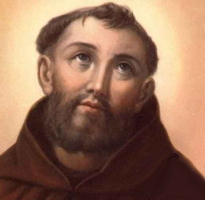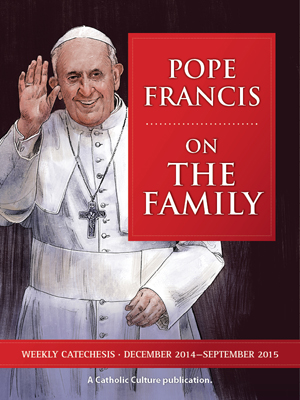Easter: April 24th
Saturday of the Third Week of Easter; Optional Memorial of St. Fidelis of Sigmaringen, priest and martyr
Other Commemorations: St. Mary of Cleophas (RM); St. Mary Euphrasia Pelletier, Virgin (RM); St. Benedict Menni, Priest (RM); St. Wilfrid, Bishop (RM)
» Enjoy our Liturgical Seasons series of e-books!
St. Fidelis was born at Sigmaringen in Swabia in 1577. He practiced at first as a lawyer and so took to heart the cause of the needy that he was known as the poor man's lawyer. Then he joined the Capuchin Friars Minor and was sent by the Holy See to the Grisons in order to bring back the inhabitants of this canton from Protestantism to the Catholic faith. His great influence earned him enemies; he was murdered at Seewis on April 24, 1622.
Historically today is the feast of St. Mary of Clophas, Mother of St. James the Less and Joseph, wife of Cleophas (or Clopas or Alpheus). She was one of the "Three Marys" who served Jesus and was present at the Crucifixion , and accompanied Mary Magdalen to the tomb of Christ. Tradition reports that she went to Spain as a missionary. Mary reportedly died at Ciudad Rodrigo. Another tradition states that she went to France with St. Lazarus and his sisters.
According to the Roman Martyrology, today is the feast of St. Euphrasia Pelletier who founded the Congregation of Our Lady of Charity of the Good Shepherd, more commonly known as Sisters of the Good Shepherd. St. Benedict Menni was an Italian Roman Catholic priest. He was a professed member of the Hospitallers of Saint John of God and he went on to establish his own religious congregation known as the Hospitaller Sisters of the Sacred Heart of Jesus. Today is his feast day as well.
The Roman Martyrology also commemorates St. Wilifrid (634-709). St. Wilfrid was born in Northumbria and studied at Lindisfarne and Canterbury. Accompanying St. Benedict Biscop to Rome, he tarried for a whole year at Lyons with St. Delphinus, who tried to make him marry his niece. Named Bishop of York, he went to France to receive episcopal consecration and remained for two years. Wilfrid was to suffer from the lack of obedience shown by his fellow citizens toward the Apostolic See. The end of his life was almost exclusively devoted to the care of the monasteries he had founded.
St. Fidelis
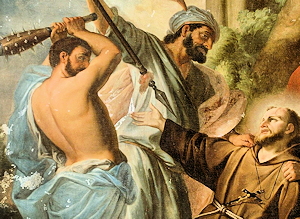 Fidelis has been called the "protomartyr of the Capuchin Order and of the Propaganda in Rome." He was born in 1577, became a renowned lawyer. But feeling that this profession endangered the salvation of his soul, he decided to join the Capuchin Order and employ his extraordinary gift of eloquence in urging the faithful to lead holy lives and in bringing heretics back to the true faith. An ardent admirer of the founder of his Order, he was a great friend of poverty. Severe with himself, he was most considerate towards others, "embracing them like a mother does her children." When the Austrian army was stricken by plague, he cared for the spiritual and bodily needs of the soldiers in such a manner that he was honored with the title, "Father of the Fatherland."
Fidelis has been called the "protomartyr of the Capuchin Order and of the Propaganda in Rome." He was born in 1577, became a renowned lawyer. But feeling that this profession endangered the salvation of his soul, he decided to join the Capuchin Order and employ his extraordinary gift of eloquence in urging the faithful to lead holy lives and in bringing heretics back to the true faith. An ardent admirer of the founder of his Order, he was a great friend of poverty. Severe with himself, he was most considerate towards others, "embracing them like a mother does her children." When the Austrian army was stricken by plague, he cared for the spiritual and bodily needs of the soldiers in such a manner that he was honored with the title, "Father of the Fatherland."
His devotion toward the Mother of God was truly remarkable. Trusting in her intercession and that of other saints, he often begged God for the grace of sacrificing his life in vindication of the Catholic faith. The occasion came when he was appointed to lead the mission for the conversion of Grisons (in Switzerland); heroically he suffered a martyr's death and sanctified with his blood the first-fruits of martyrdom in the Capuchin Order (1622).
—Excerpted from The Church's Year of Grace by Pius Parsch
Symbols and Representation: With a club set with spikes; with a whirlbat or hurl bat; heretics; with Saint Joseph of Leonissa; trampling on the word heresy; with an angel carrying a palm of martyrdom; the Morning Star
Highlights and Things to Do:
- Read more about St. Fidelis:
- Since St. Fidelis was an excellent preacher and was chosen by the Congregation for the Propagation of the Faith to combat the heresy of Calvinism maybe you might study a little apologetics to prepare yourself to defend the Faith. You can start with this article: A Tiptoe through TULIP.
- From Wikipedia regarding St. Fidelis' relics:
It is said that a Catholic woman lay concealed near the place of Fidelis' martyrdom as the saint was slain. After the soldiers had left, she came out to assess the incident and found the martyr's eyes open, fixed on the heavens. He was buried by Catholics the next day.
The rebels were soon after defeated by the imperial troops, an event which the martyr had foretold. The Protestant minister who had participated in Fidelis' martyrdom was converted by this circumstance, made a public abjuration of Calvinism and was received into the Catholic Church.
After six months, the martyr's body was found to be incorrupt, but his head and left arm were separated from his body. The body parts were then placed into two reliquaries, one sent to the Cathedral of Coire, at the behest of the bishop, and laid under the High Altar; the other was placed in the Capuchin church at Weltkirchen, Feldkirch, Austria.
St. Mary of Cleophas (also Mary of Clopas)
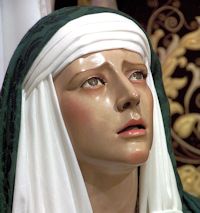 "And there were standing by the cross of Jesus His mother and His mother's sister, Mary of Cleophas, and Mary Magdalen." How should we understand "His mother's sister," literally, as in having the same parents, or in the same sense that Jesus's "brothers" are to be understood as close relatives?
"And there were standing by the cross of Jesus His mother and His mother's sister, Mary of Cleophas, and Mary Magdalen." How should we understand "His mother's sister," literally, as in having the same parents, or in the same sense that Jesus's "brothers" are to be understood as close relatives?
The short answer is that Mary of Cleophas is probably the Blessed Virgin's sister-in-law. Mary of Cleophas may have had a previous husband named Alpheus, or this Alpheus may have been Cleophas. The Blessed Virgin Mary, of course, only had one husband (Joseph) and remained a virgin. The long answer may be found here.
There is also a theory that Mary might have been the unnamed disciple on the road to Emmaus.
Highlights and Things to Do:
- Find out more about who St. Mary of Cleophas was:
St. Mary Euphrasia Pelletier
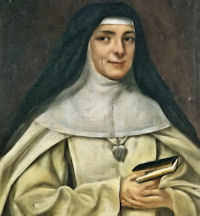 On May 2, 1940, Pope Pius XII raised to the ultimate honors of the altar a most remarkable woman, Mother Mary Euphrasia Pelletier. As the solemn Te Deum swelled in gladness through the Vatican Basilica, its joyous strains were echoed and reechoed in quiet chapels found in virtually all the large cities of the world. Almost a hundred thousand women and girls and over ten thousand white-robed Sisters, in three hundred and fifty homes of charity, rejoiced with their Mother, the new Saint. For Saint Mary Euphrasia Pelletier is the Foundress and first General Superior of the large Congregation of Our Lady of Charity of the Good Shepherd of Angers, and one of the great sociologists of the ages.
On May 2, 1940, Pope Pius XII raised to the ultimate honors of the altar a most remarkable woman, Mother Mary Euphrasia Pelletier. As the solemn Te Deum swelled in gladness through the Vatican Basilica, its joyous strains were echoed and reechoed in quiet chapels found in virtually all the large cities of the world. Almost a hundred thousand women and girls and over ten thousand white-robed Sisters, in three hundred and fifty homes of charity, rejoiced with their Mother, the new Saint. For Saint Mary Euphrasia Pelletier is the Foundress and first General Superior of the large Congregation of Our Lady of Charity of the Good Shepherd of Angers, and one of the great sociologists of the ages.
Rose Virginia Pelletier was born of pious parents on July 31, 1796 on the island of Noirmoutiers, during the terrible period of the French Revolution. So it was that her life began as a daughter of the suffering faith of her beloved France. Because of the suppression and expulsion of religious Orders, the education of the little girl had to be undertaken by her busy mother. At her knees Rose Virginia learned of God and His service.
In 1814 she entered the Order of Our Lady of Charity of the Refuge at Tours. After ten months as a postulant in this historic community at Tours, Rose Virginia received the habit and entered upon her life as a novice in September, 1815. For two years she remained in the novitiate, being formed to the religious life, studying and absorbing the history and work of her Order. Listening to the life of a Saint one day, she heard that he quickly attained sanctity by his perfect obedience. “Obedience, then,” reflected the young novice, “must be the best means to become holy. If only I might take the vow of obedience at once!” Sister Mary Euphrasia consulted her superiors, and was permitted to take a private vow of obedience. In 1817 she was professed, making then her first public vows.
In a few years her exceptional qualifications became so apparent to all that after having been Mistress of penitents, she was elected Superior of the house. A project which had been in her mind for a long time was then made a reality. She had found in many of the penitents a real attraction for the religious life, with no desire to return to the world after their conversion. Where could they go? It was very difficult, virtually impossible, to find a congregation suitable for them or willing to accept them. So Mother Euphrasia inaugurated a community called the Magdalene Sisters. She adapted the rule of Saint Teresa, drew up a set of Constitutions, and erected the first community of Magdalenes in the house at Tours. One of the greatest consolations Mother Euphrasia enjoyed in life was the sanctity attained by so many of these religious, bound by vows to a life of prayer and penance.
During the thirty years she was Superior General, Mother Euphrasia sent out her Sisters from their mother house at Angers to found one hundred and ten houses in every land beneath the sun — Sisters inflamed with her own zeal, trained at her hands. She died at Angers in her seventy-second year, having welcomed death with the faith and serenity which marked her entire life.
Patronage: travelers.
Highlights and Things to Do:
- Read more about St. Mary Euphrasia:
- CIN
- Sisters of the Good Shepherd
- Catholicsaints.info especially for the e-books
- You can read the Life of Reverend Mother Mary of St. Euprasia online here.
- See her statue in St. Peter's Basilica in Rome.
- Find out more about the religious order St. Mary Euphrasia established: at Catholic Encyclopedia, Sisters of the Good Shepherd and Wikipedia.
- St. Mary Euphrasia's body is buried on the property of the Motherhouse of the Sisters of the Good Shepherd in Angers, France.
St. Benedetto (or Benedict) Menni
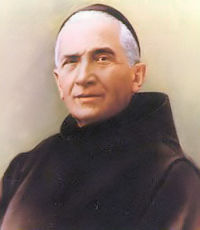 Brothers of St. John of God care for the sick and those in need. For this reason, from the very beginning, the Hospitaller Order was recognized by the Church as a Congregation of religious brothers with exception of not more than one priest in each community acting as chaplain.
Brothers of St. John of God care for the sick and those in need. For this reason, from the very beginning, the Hospitaller Order was recognized by the Church as a Congregation of religious brothers with exception of not more than one priest in each community acting as chaplain.
Saint Benedetto Menni was one exception, being an ordained priest in Rome on October 14, 1860. In those years, the Spanish branch of the Hospitallers Order died away as a consequence of some Masonic laws issued in Portugal in 1834 and in Spain in 1835. Saint Benedict was sent to Barcelona on April 6, 1867, to restore the Hospitaller Order in these countries.
After a long struggle, oftentimes risky, he was not only able to gather many vocations—almost a thousand from 1867 to 1903—but also founded in Spain, Portugal and Mexico, 22 hospitals for every kind of sickness, especially for mental patients and handicapped children. Those conditions were the most neglected by the public health care at that time.
He also founded a female branch of the Order, the Hospitaller Sisters of the Sacred Heart of Jesus. Today, the Sisters are present in 20 countries with almost 80 communities.
What is amazing in the life work of Saint Menni is the number and complexity of the undertakings he faced; but, even more so for their validity, tested for more than a century. The secret lies in his true, heroic detachment by which he always considered himself a docile instrument in the hands of God, without giving room for his personal ambitions or human plans.
His feast day is April 24, the day he died in Dinan, France, in 1914.
—©The Hospitaller Foundation of California, Inc.
Highlights and Things to Do:
- Read more about St. Benedetto Menni:
- Learn about the Sisters Hospitallers.
- Read Catholic Herald: "The priest who changed the way we treat the mentally ill".
- His relics are located at the Mother House of the Congregation of Hospitaller Sisters of the Sacred Heart of Jesus in Ciempozuelos, Spain.
St. Wilfrid
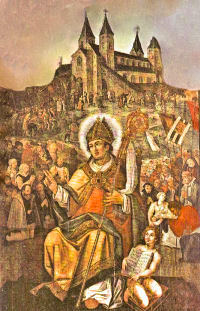 St. Wilfrid was a Northumbrian of noble birth. He was educated at Lindisfarne, and became infected with a love both for learning and the monastic life. When quite a young man he traveled to Canterbury and then to Rome. On his return, he founded monasteries at Ripon and Stamford, and became prominent as the successful protagonist of the Roman customs at the Synod of Whitby, 664 A.D.
St. Wilfrid was a Northumbrian of noble birth. He was educated at Lindisfarne, and became infected with a love both for learning and the monastic life. When quite a young man he traveled to Canterbury and then to Rome. On his return, he founded monasteries at Ripon and Stamford, and became prominent as the successful protagonist of the Roman customs at the Synod of Whitby, 664 A.D.
He was then made Bishop of York, and went to France to be consecrated. In his absence Chad was consecrated and made Bishop of York in his place, and held the see for four years. During this time Wilfrid founded a monastery at Oundle and acted as bishop in Mercia. He was then installed at York by Archbishop Theodore, and ruled the see for nine years. He also founded the Abbey of Hexham. He managed to gain the ill-will of Egfrith, King of Northumbria, and Archbishop Theodore, who divided his diocese in four parts without his knowledge or consent.
He journeyed to Rome, and his appeal was successful, but on his return to Northumbria he was accused of having forged the pope's bull, and was thrown into prison. After his release he went to Sussex, and for five years preached the Gospel to its pagan inhabitants. When he went there the country was suffering from famine, the result of three years' drought, and its inhabitants were drowning themselves in despair. Wilfrid gained their goodwill by teaching them to fish.
"By this benefit the bishop gained the affections of them all, and they began more readily to hope for heavenly blessings, since by his help they had already received those which are temporal." His labors seem to have been abundantly successful, and he added to his success by establishing a monastery at Selsey.
Archbishop Theodore, now on his deathbed, became reconciled to Wilfrid, and even wished to nominate him as his successor in the See of Canterbury. This, however, Wilfrid refused, but used Theodore's good offices to secure his return to Northumbria.
After a few years his enemies seem to have made his position so difficult that he retired to Mercia, and when St. Chad died he succeeded to his position as Bishop of Lichfield, and labored in that diocese for ten years. He was recalled to be tried by a Northumbrian council of nobles and bishops, was once more condemned, and once more appealed to Rome. Once again his appeal was successful, and this time the Roman judgment was accepted in Northumbria.
The few remaining years of his life were spent in comparative retirement, principally at Hexham and Ripon. His last public act was the consecration of Evesham Abbey; he died on his way home at his monastery at Oundle in the year 709, and was buried at Ripon.
Wilfrid was one of the most versatile and accomplished men of his own or any other age. He was a great builder, a lover of learning, and a musician; he knew how to create splendid effects through art and through religious ceremonial. He was also a founder and a builder in men as well as stones. He was, in fact, a great creative artist.
Patronage: Middlesbrough, England; diocese of Ripon, England
Symbols and Representation: Fallen idols; fish; font; pallium and crosier; model of a cathedral; ship and staff; depicted baptizing; depicted preaching; landing from a ship and received by the king; or engaged in theological disputation with his crozier near him and a lectern before him
Highlights and Things to Do:
- Read more about St. Wilfrid of York:
- Read more about St. Wilfrid and the Monastery at Ripon.
- Visit this In Search of St. Wilfrid, an Anglican site, for a collection of articles about St. Wilfrid which thoroughly explores his life and times. (St. Wilfrid predates Henry VIII and therefore all the information is about the Catholic Church.)


